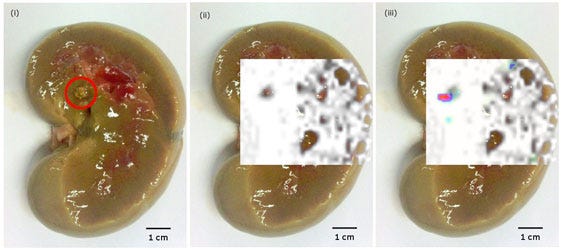Inexpensive Imaging Technology Provides Higher Clarity than Ultrasound, MRI
March 23, 2011
|
(i) Section through a sheep's kidney, into which a calcium carbonate nodule has been inserted as a proxy for a kidney stone or vascularized tumor-location shown by red ring. |
A patented imaging technology offers higher clarity at a lower price than conventional imaging modalities, according to its developers at the University of Oxford. The technology could allow for faster and easier diagnosis of various types of cancer.
Oxford electromagnetic acoustic imaging (OxEMA) employs electromagnetic and acoustic waves to produce what the researchers claim is "unparalleled tissue-type characterization in this price bracket." Capable of discriminating between different electrical and mechanical properties of tissue, the technology facilitates the identification of abnormalities that are not easily distinguishable by conventional ultrasound, for example. As a result, the imaging technology may improve diagnosis of kidney, liver, breast, and thyroid cancer. It may also have application in orthopedics and other areas.
"OxEMA has the capability of producing MRI-like images because it utilizes the electromagnetic properties of tissue as the contrast mechanism. However, in combination with ultrasound, we can achieve images of high spatial resolution without the use of large expensive magnets, keeping the size and cost of the system much lower than MRI," says professor David Edwards, who is leading the project. Unlike x-ray and CT scanning, the technology also offers the advantage of being nonionizing, which is beneficial to patients.
The scientists are currently seeking investment to create a spinout company for the purpose of building an imaging system based on OxEMA technology and taking it through initial engineering and regulatory stages.
You May Also Like


.png?width=300&auto=webp&quality=80&disable=upscale)
